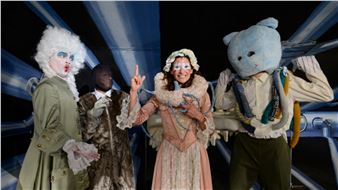Francesco Clemente: Tents
First used as dwellings over 3000 years ago, tent-like structures present an environment of shelter that can be traced back to antiquity. ClementeвҖҷs tents engage with this long history but are characterised by a discontinuity or fragmentation of context, bringing together myriad cultural and art historical references. Each of the structures immerses the viewer in a rich, colour-infused environment that melds Eastern and Western traditions of art, philosophy and religion, reflecting the artistвҖҷs nomadic desire not to belong.
Produced in India, Clemente describes these tents as his вҖҳcave paintingsвҖҷ which can be sheltered and slept under, or daydreamed and prayed within; these are movable chapels for contemplation of the sacred in a modern age defined by digital speed. Expanding the traditional relationship between art object and viewer, these paintings function by enveloping and surrounding the viewer to evoke an experience of painting that is both seen and physically felt.

Recommended for you
First used as dwellings over 3000 years ago, tent-like structures present an environment of shelter that can be traced back to antiquity. ClementeвҖҷs tents engage with this long history but are characterised by a discontinuity or fragmentation of context, bringing together myriad cultural and art historical references. Each of the structures immerses the viewer in a rich, colour-infused environment that melds Eastern and Western traditions of art, philosophy and religion, reflecting the artistвҖҷs nomadic desire not to belong.
Produced in India, Clemente describes these tents as his вҖҳcave paintingsвҖҷ which can be sheltered and slept under, or daydreamed and prayed within; these are movable chapels for contemplation of the sacred in a modern age defined by digital speed. Expanding the traditional relationship between art object and viewer, these paintings function by enveloping and surrounding the viewer to evoke an experience of painting that is both seen and physically felt.















